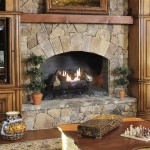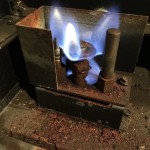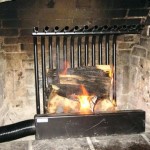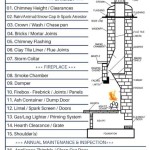Hanging a TV on a Rock Fireplace Wallpaper: Considerations and Best Practices
The pursuit of a visually appealing and functional living space often leads homeowners to consider combining focal points such as a television and a fireplace. A particularly trendy option involves applying rock-effect wallpaper to the fireplace surround, creating a rustic or modern aesthetic. However, integrating a television into this design requires careful planning and execution. This article will explore the various aspects of safely and effectively hanging a TV on a rock fireplace wallpaper, addressing structural considerations, installation techniques, and design implications.
The allure of rock fireplace wallpaper lies in its ability to mimic the texture and appearance of natural stone without the weight and cost. It provides an excellent backdrop for a fireplace feature, enhancing the room's ambiance. When considering placing a television above this feature, it's crucial to approach the project systematically to ensure both safety and aesthetic harmony. Neglecting essential steps may lead to structural damage, electrical hazards, or an aesthetically displeasing result.
Assessing Wallpaper Compatibility and Wall Structure
Before embarking on the mounting process, a thorough assessment of the wallpaper and the underlying wall structure is paramount. Not all rock-effect wallpapers are created equal. Some are thin and delicate, while others are thicker and more durable. The thickness and composition of the wallpaper will influence the type of mounting hardware and techniques that can be employed.
The substrate beneath the wallpaper, whether it's drywall, plaster, or brick, plays an even more critical role. Drywall, being the most common material, offers relatively limited support compared to brick or concrete. The wall's framing, including the stud placement, is also essential information for securely anchoring the TV mount. Wall studs are vertical structural members within a wall, providing points to securely attach objects such as TVs. Typically, wall studs are spaced 16 or 24 inches apart, measured from center to center.
To accurately ascertain the wall structure, a stud finder is an invaluable tool. This device identifies the location of studs behind the wall surface. Once the stud locations are determined, they should be marked clearly. If the studs are not located in an ideal position for the TV mount, alternative solutions, like using a bridging board or specialized anchors, need to be investigated. A bridging board, typically made of wood, can be secured to the wall studs and provide a wider surface area for mounting the TV bracket. Specialized anchors are designed to distribute the weight of the TV across a larger area of the wall, compensating for the drywall's limited inherent strength.
If the wall happens to be brick or concrete, the approach differs significantly. These materials provide a substantially more robust base for mounting. However, specialized drilling techniques and heavy-duty anchors are required to penetrate the hard surface and ensure a secure hold. It is recommended to consult a professional when dealing with brick or concrete walls, especially if unfamiliar with power tools and masonry techniques.
The type of rock fireplace wallpaper also affects how securely the mounting hardware can grip the wall. Thicker, textured wallpaper might create an uneven surface, preventing the mount from sitting flush against the wall, which can compromise stability. Consider how much the wallpaper protrudes from the wall and if any special tools, such as washers, are needed to ensure the bracket sits flat. Depending on the situation, removing a small section of the wallpaper where the mount will be attached may be necessary to achieve a solid connection.
Choosing the Right TV Mount and Hardware
Selecting the appropriate TV mount and mounting hardware is a critical step in the process. The weight and size of the television are primary factors in determining the load-bearing requirements of the mount. Ensure the chosen mount is rated to support the weight of the TV, with a safety margin to account for any potential stress or movement. There are several types of TV mounts available, each offering different functionalities and aesthetic considerations.
Fixed mounts are the simplest and most economical option. They hold the TV close to the wall, providing a clean, low-profile look. However, they offer limited adjustability once installed. Tilting mounts allow the TV to be angled slightly, which can reduce glare and improve viewing angles, especially when the TV is mounted higher on the wall. Full-motion mounts, also known as articulating mounts, provide the greatest flexibility. They allow the TV to be extended, swiveled, and tilted, offering optimal viewing angles from various positions in the room. These mounts are particularly useful in rooms with multiple seating areas or when the TV needs to be angled to avoid reflections.
Regardless of the type of mount selected, the mounting hardware must be compatible with the wall material and the TV. For drywall installations, use lag bolts anchored into the wall studs. When studs are not optimally located, use toggle bolts or heavy-duty drywall anchors to distribute the weight across a larger area. Toggle bolts are designed with “wings” that spread out behind the drywall, providing a secure hold. Heavy-duty drywall anchors, also known as molly bolts, are similar to toggle bolts but use a different mechanism to expand and grip the drywall.
For brick or concrete walls, use masonry screws or expansion anchors designed for these materials. These anchors are specifically designed to withstand the compressive forces of masonry and provide a reliable hold. Always consult the manufacturer's instructions for the recommended drill bit size and installation procedure. It is also essential to ensure that the screws or bolts are long enough to penetrate the wall sufficiently and engage the anchoring mechanism properly. Using the incorrect hardware could lead to mount failure and potential damage or injury.
Considerations should be given to cable management as well. Choose a mount that provides routing options for cables to minimize clutter and maintain a clean aesthetic. Cable management solutions, such as cable sleeves and wall plates, can help conceal the wires running from the TV to other devices, contributing to a more organized and visually appealing installation.
Installation Technique and Safety Precautions
The installation process requires meticulous attention to detail and adherence to safety protocols. Before starting, turn off the power to any electrical outlets or wiring in the vicinity. This minimizes the risk of electric shock during the installation. Gathering all necessary tools and materials beforehand ensures a smooth and efficient process. These tools often include a stud finder, drill, level, screwdriver, measuring tape, pencil, and safety glasses.
Begin by carefully removing any existing items on the wall that might obstruct the installation, such as pictures or decorations. If the wallpaper is damaged in any place, repair it before proceeding to ensure a more secure mount. Use a level to align the mount horizontally before marking the screw holes. Precise measurement and alignment are critical for ensuring the TV is level and centered on the wall. Drill pilot holes at the marked locations, using the appropriate drill bit size for the wall material and the chosen anchors. Use safety glasses to protect eyes from dust and debris.
Attach the TV mount bracket to the wall, ensuring that all screws are tightened securely. Double-check the leveling and stability of the mount before proceeding. If installing a full-motion mount, test the range of motion to ensure it functions smoothly. With assistance, carefully lift the TV and attach it to the mounted bracket according to the manufacturer's instructions. Ensure that all connections are secure and that the TV is stable before releasing it.
After the TV is mounted, organize and conceal the cables. Use cable sleeves or wall plates to hide the wires running from the TV to peripheral devices. Secure the cables to the wall and trim away any excess wallpaper to ensure a neat finish. Once the cables are properly managed, turn the power back on and test the TV to ensure proper functionality. Verify that the picture and sound are working correctly and that all connected devices are functioning as expected.
Regularly inspect the TV mount for any signs of loosening or deterioration. Check the screws and anchors to ensure they are still securely fastened. If any issues are detected, tighten the screws or replace the anchors as needed. By following these guidelines and prioritizing safety, a TV can be securely and aesthetically integrated with a rock fireplace wallpaper, enhancing the entertainment and design of the living space.

Pin By Lino Vargas On Guardado Rápido Fireplace Tv Wall Accent Walls In Living Room Design

Mounting A Tv Above Fireplace With Full Tutorial Fixthisbuildthat

Modern Meets Rustic Stacked Stone Fireplace Tv Wall

Mounting A Tv Above Fireplace With Full Tutorial Fixthisbuildthat

Made How To Mount A Flat Screen Tv On Stone Fireplace Diy

How To Hang Tv On Stone Fireplace In 6 Proven Steps Delight

Home Decor Modern Stone Tv Wall Design Ideas You Ll Love Fireplace Unit Living Room

Stone Fireplace Tv Wall Full Build

Mounting A Tv Above Fireplace With Full Tutorial Fixthisbuildthat

Mantelmount How To Mount Your Tv Above A Fireplace Infarrantly Creative








